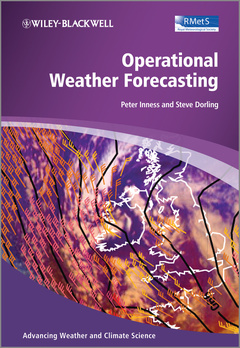Operational Weather Forecasting Advancing Weather and Climate Science Series
Auteurs : Inness Peter Michael, Dorling Steve

This book offers a complete primer, covering the end-to-end process of forecast production, and bringing together a description of all the relevant aspects together in a single volume; with plenty of explanation of some of the more complex issues and examples of current, state-of-the-art practices.
Operational Weather Forecasting covers the whole process of forecast production, from understanding the nature of the forecasting problem, gathering the observational data with which to initialise and verify forecasts, designing and building a model (or models) to advance those initial conditions forwards in time and then interpreting the model output and putting it into a form which is relevant to customers of weather forecasts. Included is the generation of forecasts on the monthly-to-seasonal timescales, often excluded in text-books despite this type of forecasting having been undertaken for several years.
This is a rapidly developing field, with a lot of variations in practices between different forecasting centres. Thus the authors have tried to be as generic as possible when describing aspects of numerical model design and formulation. Despite the reliance on NWP, the human forecaster still has a big part to play in producing weather forecasts and this is described, along with the issue of forecast verification ? how forecast centres measure their own performance and improve upon it.
Advanced undergraduates and postgraduate students will use this book to understand how the theory comes together in the day-to-day applications of weather forecast production. In addition, professional weather forecasting practitioners, professional users of weather forecasts and trainers will all find this new member of the RMetS Advancing Weather and Climate series a valuable tool.
- Provides an end-to-end description of the weather forecasting process
- Clearly structured and pitched at an accessible level, the book discusses the practical choices that operational forecasting centres have to make in terms of what numerical models they use and when they are run.
- Takes a very practical approach, using real life case-studies to contextualize information
- Discusses the latest advances in the area, including ensemble methods, monthly to seasonal range prediction and use of ?nowcasting? tools such as radar and satellite imagery
- Full colour throughout
- Written by a highly respected team of authors with experience in both academia and practice.
- Part of the RMetS book series ?Advancing Weather and Climate?
Series Foreword vii
Preface ix
Acknowledgements xiii
1 Introduction 1
1.1 A brief history of operational weather forecasting 2
2 The Nature of theWeather Forecasting Problem 9
2.1 Atmospheric predictability 9
2.2 The importance of observations in weather forecasting 13
2.3 An overview of the operational forecast process 17
Summary 25
3 Meteorological Observations 27
3.1 What do we need from a meteorological observing system? 27
3.2 Data transmission and processing 29
3.3 Observing platforms 31
Summary 51
4 NWP Models – the Basic Principles 53
4.1 The basic ingredients of an NWP model 55
4.2 Building the physical principles into a model 79
4.3 Setting the initial conditions for the forecast 89
Summary 107
5 Designing Operational NWP Systems 109
5.1 Practical considerations for an NWP suite 109
5.2 Ensemble prediction systems 124
5.3 Model output – what can NWP models produce? 130
5.4 Using NWP output to drive other forecast models 144
Summary 148
6 The Role of the Human Forecaster 149
6.1 The role of the senior forecasting team 150
6.2 Production of forecasts for customers 163
Summary 175
7 Forecasting at Longer Time Ranges 177
7.1 Where does the predictability come from in longer range forecasts? 178
7.2 Observations of ocean and land surface variables 185
7.3 Monthly to seasonal forecasting systems 187
7.4 Presentation of longer range forecasts 200
Summary 204
8 Forecast Verification 205
8.1 Deterministic forecast verification 208
8.2 Verification of probability forecasts 216
8.3 Subjective verification 219
Summary 222
References 223
Index 227
Peter Inness is a lecturer in the Meteorology Department of Reading University having previously been a Reasearch fellow in the Climate Division of the NERC funded National Centre for Atmospheric Science based at the University of Reading.
Steve Dorling is Senior Lecturer and Researcher in the School of Environmental Sciences at the University of East Anglia (UEA). Steve is also Innovations Director at UEA-based Weatherquest Ltd.
Date de parution : 02-2013
Ouvrage de 248 p.
17x24.4 cm
Date de parution : 02-2013
Ouvrage de 248 p.
17.5x25.2 cm
Thème d’Operational Weather Forecasting :
Mots-clés :
primer; endtoend; production; process; forecast; single volume; aspects; relevant; description; explanation; examples; issues; complex; plenty; current; weather; operational; whole; nature; problem; forecasting; data



